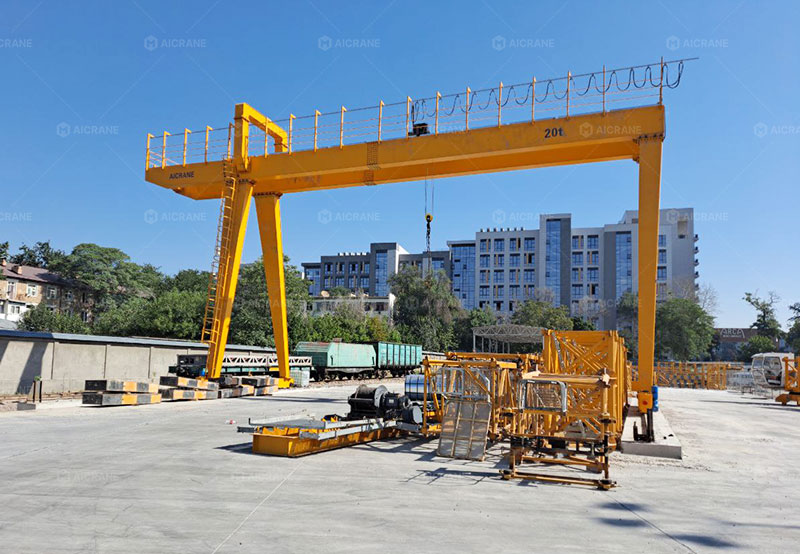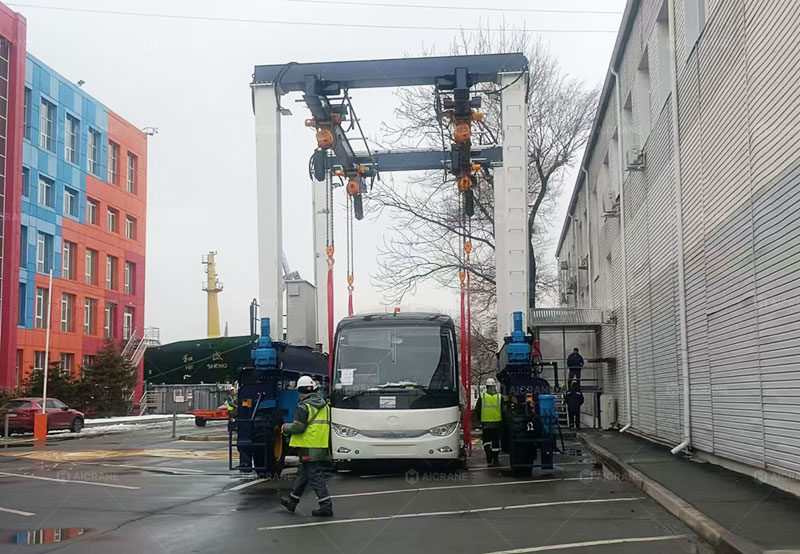Designing a 20-ton gantry crane is a highly technical task that requires a balance between efficiency, performance, and safety. Among the many engineering principles applied, the concept of a safety factor (sometimes referred to as a factor of safety or FoS) stands at the forefront. Safety factors ensure that the crane not only performs its intended function under normal operating conditions but also has enough reserve strength to handle unexpected stresses, loads, and environmental factors. This article explores in depth the role of safety factors in 20-ton gantry crane design, including structural, mechanical, and operational considerations.

Understanding Safety Factors in Crane Design
A safety factor is essentially a design margin incorporated to account for uncertainties in calculations, material properties, and real-world usage conditions. For gantry cranes, this means that structural members, lifting components, and load-bearing systems are designed to handle forces beyond the crane’s rated capacity.
For example, a 20 ton gantry crane rated for a maximum safe working load (SWL) of 20 tons will typically have critical components designed to withstand loads much higher – sometimes 1.5 to 2 times the rated capacity, depending on international standards and regulations. This ensures that the crane does not fail under sudden overload, shock loads, or material inconsistencies.
Key Areas Where Safety Factors Apply
1. Structural Framework
The main girders, end beams, and supporting legs of a 20-ton gantry crane must be designed with sufficient safety margins. Engineers use advanced calculations and finite element analysis (FEA) to predict stresses and deflections.
-
Safety factor range: Typically between 1.5 and 2.0 for structural elements.
-
Purpose: To handle unexpected bending moments, fatigue over long operational cycles, and extreme weather conditions such as wind or seismic loads.
-
Example: A girder expected to support 20 tons safely may actually be capable of handling 30–35 tons before structural failure, though operators are never permitted to load it that way.
2. Hoisting Mechanism
The hoist is the heart of any gantry crane for sale. Its motor, gearbox, drum, and rope or chain system must all be designed with adequate safety margins.
-
Wire ropes: International standards often require a breaking load of the rope to be at least 5–7 times the maximum working load.
-
Hooks: Forged hooks used in a 20-ton crane often follow a minimum safety factor of 4–5 against failure.
-
Motors and brakes: Motors are typically oversized relative to the rated load to handle transient surges, while brakes are designed to withstand loads far above 20 tons for emergency stops.
3. Runway and Wheels
The wheels, rails (if applicable), and supporting surfaces also require safety margins to prevent collapse or excessive wear.
-
Wheel load calculation: The load is not evenly distributed across all wheels; hence, a safety factor ensures that localized stress does not result in track or wheel failure.
-
Rail foundation: Designed with at least 1.5 safety factor to resist settlement, uneven load distribution, or vibrations.
4. Electrical and Control Systems
While not directly load-bearing, electrical and automation systems play a key safety role. Overload protection, emergency cut-offs, and anti-sway devices are designed to exceed operational thresholds.
-
Circuit breakers and fuses: Typically rated higher than maximum expected current to avoid failures under surge conditions.
-
Sensors: Load cells and limit switches are tested with redundant safety margins to prevent false readings or missed overload conditions.

Factors Influencing the Choice of Safety Factor
Not all gantry cranes require the same safety factor. For a 20-ton double girder gantry crane for sale, the chosen value depends on several critical considerations:
-
Application Environment
-
Heavy industry: Higher safety factors are often applied in steel plants or shipyards due to higher risk of shock loads and continuous use.
-
Light-duty settings: Warehouses or assembly shops may use slightly lower safety factors as operational stresses are predictable.
-
-
Frequency of Use
A crane used in continuous operation (duty class A6–A8 under FEM or CMAA standards) will require higher safety margins than one used occasionally. -
Regulatory Standards
Different countries adopt different guidelines:-
CMAA (U.S.): Provides safety factor recommendations for mechanical and structural components.
-
FEM (Europe): Classifies cranes by duty cycle, influencing design margins.
-
ISO: Defines general safety principles for lifting machinery.
-
-
Material Variability
Variations in steel quality, weld strength, or rope manufacturing can influence safety factor selection. A higher margin compensates for these uncertainties. -
Environmental Conditions
Corrosive marine atmospheres, extreme cold, or seismic activity demand additional safety reserves.
Balancing Safety Factor with Cost and Efficiency
While higher safety factors improve reliability, they also increase material usage, weight, and cost. For example:
-
Designing the crane’s main girder with a safety factor of 3 instead of 2 may require thicker steel plates, leading to higher fabrication costs and increased self-weight.
-
Oversized motors and ropes consume more energy and raise procurement costs.
Therefore, engineers must balance safety with economic efficiency. In most 20-ton gantry crane designs, an FoS between 1.5 and 2.5 for structural components, and higher values (up to 7) for ropes and hooks, achieves this balance.
Consequences of Ignoring Safety Factors
Failure to apply proper safety factors can lead to catastrophic accidents, including:
-
Structural collapse of girders or legs under unexpected overloads.
-
Rope or hook failure during lifting, causing dropped loads and workplace fatalities.
-
Wheel derailment due to inadequate design margins for uneven loading.
-
Electrical hazards if circuits or overload protections are not adequately rated.
Real-world accidents have shown that cutting corners in design margins not only risks human lives but also causes financial losses, downtime, and legal liabilities.
Engineering Practices for Ensuring Proper Safety Factors
-
Simulation and Testing
Using finite element analysis (FEA) to predict load behavior under various conditions. -
Prototype Testing
Load testing industrial gantry cranes at 125–150% of rated capacity to verify structural integrity before commissioning. -
Quality Assurance in Materials
Ensuring that steel plates, ropes, and components meet international specifications. -
Redundancy in Critical Systems
For example, dual brakes on hoists or backup limit switches provide an additional layer of safety. -
Regular Inspection and Maintenance
Even with strong safety factors, wear and tear can compromise reliability. Routine inspections confirm that the original design margins remain intact throughout the crane’s service life.
Conclusion
Safety factor considerations are central to the design of a 20-ton gantry crane. From the structural framework and hoisting system to wheels, controls, and electrical components, every part of the crane incorporates design margins to protect against failure. The choice of safety factor is influenced by duty class, operating environment, material properties, and regulatory requirements. While higher safety factors improve safety, they must be balanced against cost and efficiency to ensure a practical, economical design.
Ultimately, the proper application of safety factors not only ensures compliance with international standards but also guarantees reliable, long-term performance. For customers and operators, understanding these design principles provides peace of mind that their 20-ton gantry crane is engineered for both strength and safety.